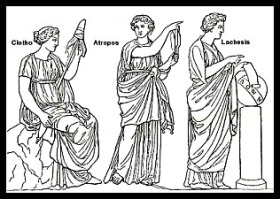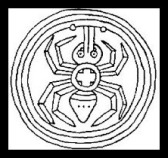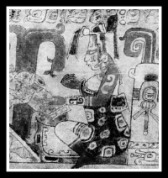►Mythology: “Dogs in Several Myths”🐕:
“Collaboration with Brenda Davis Harsham💫”


Artemis & Dog. Roman copy of the 1st cent. CE after a Greek original, 4th cent. BCE. Rome, Vatican Museums.

________________________________________________________________________________________
►Introduction:
The dog is the first domesticated animal, and is symbolically associated with loyalty and vigilance, often acting as guardian and protector. Dogs are portrayed as guides and companions, hence the notion of “man’s best friend.”
Dogs almost always appear in a positive light. Native American legends generally portray the dog as the symbol of friendship and loyalty. The Joshua Athapascans believe that dogs were the first beings made by their creator-figure, Xowala’ci. The Jicarilla Apache, on the other hand, tell the story of God Black Hactcin, who first created a dog and then made man as a companion for the dog.
In Irish Mythology, dogs were the traditional guardian animals of roads and crossways and are believed to protect and guide lost souls in the Underworld. Irish seers chewed the meat of a dog in a ritual to gain prophetic vision. To be called “hound” was an honorable nickname for a courageous warrior; the name of the god Cuchulain is literally “Hound of Culann” or “Hound of Ulster”.
Cuchulain was named Sétanta when he was born. Sétanta killed a blacksmith’s Celtic hound in self-defense. When Culann, the blacksmith asked who would now guard his shop the young Sétanta offered to take the dog’s place thus gaining himself the title of Cuchulain, ‘The hound of Culann’. The offer was turned down and “Cuchulainn” (former Sétanta) went on to become one of the greatest warrior legends of that era, and the nickname stuck.

Cartonnage Anubis mask.
In Ancient Egypt, the dog was linked to the dog-jackal god, Anubis, who guided the soul of the deceased to the Hall of Truth where the soul would be judged by the great god Osiris. Anubis was associated with Wepwawet (also called Upuaut), another Egyptian god portrayed with a dog’s head or in canine form, but with grey or white fur. Historians assume that the two figures were eventually combined.
One of the centers of the cult of Anubis was Cynopolis, or the city of dogs. The Greeks and Romans associated Anubis with Sirius in the sky and with Cerberus in Hades.
Dogs in general were highly valued in Egypt as part of the family and, when a dog would die, the family, if they could afford to, would have the dog mummified with as much care as they would pay for a human member of the family.
________________________________________________________________________________________

A crouching or “recumbent” statue of Anubis as a black-coated wolf (from the Tomb of Tutankhamun)
_______________________________________________________________________________________
In Greek and Roman mythology, dogs often acted as guardians; the three-headed dog Cerberus, for example, guarded the entrance to the underworld. Many cultures associated dogs with death as well as with protection.
The Ancient Greeks and Romans often chose dogs as pets. They were often seen on Greek and Roman reliefs and ceramics as symbols of fidelity. Cats were not favoured over dogs, on the contrary Ancient Greeks and Romans didn’t keep cats as pets. However, occasionally, dogs appear in negative roles, such as the fighting dogs belonging to Hecate.
Dogs are also featured in Plato‘s dialogue, “Republic“. In Book II, Socrates claims that the dog is a true philosopher because dogs “distinguish the face of a friend and of an enemy only by the criterion of knowing and not knowing” and concludes that dogs must love learning, because they determine what they like and what they do not based upon knowledge of the truth.
________________________________________________________________________________________
►Dogs In Greek Mythology:
►Cerberus:
Cerberus is reminiscent of a serpent, called a “great worm” in Dante’s “Inferno” and often said to have a mane of serpents, the tail of a serpent, and the claws of a lion. The three heads of the dog look at once into the past, the present, and the future.
Cerberus was the son of Typhon and Echidna, and fulfilled his duty as “Hound of Hades” as faithfully as possible.
This dog allowed many people to enter, he didn’t let anyone leave.
However, some were able to escape from the Underworld. Orpheus lulled Cerberus to sleep by playing soothing music; Hermes did the same but used water from the river Lethe. The most famous of all, however, was Heracles, who did not use such subtle methods. Driven mad by Hera, Hercules slew his son, daughter, and his wife. Hence he was given Twelve Labors as penance for his acts. The last of these was to capture Cerberus and bring him to the land of the living. Heracles was able to do this by wrestling the dog into submission and dragging him away from Hades.
________________________________________________________________________________________

Heracles and Cerberus. detail from a Greek amphora. ca. 520-510.B.C

Cerberus & Heracles by Edward Kwong.

Hercules and Cerberus. Hofburg Imperial Palace, Vienna, Austria.

________________________________________________________________________________________
►Artemis´ and Hecate´s dogs:
The Greeks offered black dogs (and lambs) to her in sacrifice, just as they did to Artemis, for whom they are also sacred.
The myths tells that Pan gave the virgin-huntress Artemis seven dogs “which pulled down very lions when they clutched their throats and haled them still living to the fold” (Callimachus, “Hymn to Artemis”).
Hecate presided over the crossroads, and was protector of entrance ways, households and thresholds. She was always accompanied by Stygian dogs, and her approach was announced by the howling of dogs. (“Then the earth began to bellow, trees to dance, and howling dogs in glimmering light advance, ere Hecate came” Fairclough, H. R. trans. 1916. Virgil, “Aeneid”. Book 6. Cambridge, USA: Harvard University Press).
The triple-figured maiden goddess had three heads: that of a horse, a dog, and a lion. Myths tells us that the Trojan Queen Hecuba leapt into the sea after the fall of Troy and that Hecate took pity on her and transformed her into a black female dog.
________________________________________________________________________________________

“Diana ( Artemis) the Huntress”, by Luca Penni (16th Century).

Vase depicting Artemis killing Aktaion. Attic Red Figure. (470 BC).

Hecate statue by Maxine Miller

A goddess, probably Hekate or else Artemis, is depicted with a bow, dog and twin torches

Hecate depicted with three dogs heads. Cartari, Imagini colla sposizione degli dei degli antichi

Artemis-Diana with lunar-crescent | Greco-Roman marble statue | Chiaramonti Museum
________________________________________________________________________________________
►Laelaps, Zeus´Gift to Europa:
When Zeus was a baby, a dog, known only as the “golden hound” was charged with protecting the future King of Gods. This may have been the same dog Zeus later gave to Europa. Zeus had fallen deeply in love with the beautiful Europa, and, when given the chance, stole her away to the island of Crete. There he tried to seduce her by giving her three gifts: Talos, a giant bronze creature; a javelin that never missed, and Laelaps, a dog that never failed to capture its prey. Europa eventually gave the dog to Minos, King of Crete. After being cured by Procris of a terrible disease, Minos gave her the great dog Laelaps. The dog was soon sent to capture the Teumessian fox, a giant fox that could never be caught. This created a paradox, for the dog always caught its prey, and the fox could not be caught. The chase went on unto Zeus grew weary and confused of the dilemma and simply turned both into stone, frozen forever in the chase and cast them into the stars as the constellations Canis Major (Laelaps) and Canis Minor (the Teumessian fox).
________________________________________________________________________________________
►The Constellation of the Greater Dog (Alpha Canis Major):
Sirius is is the brightest star in the night sky, with 22 times the luminosity of the sun. It is located in the constellation Alpha Canis Majoris or Greater Dog. Sirius has a smaller companion white dwarf star known as The Pup or Sirius B.
Canis Major is usually seen as one of the two hunting dogs of the great hunter Orion (Sirius). The other dog is of course Canis Minor, the Lesser Dog.
One version, previously mentioned above, says that Zeus turned the Laelaps and Teumessian Fox to stone and cast them into the stars as the constellations Canis Major and Canis Minor, respectively.
According the other version, after Orion´s death, Artemis placed Orion faithful’s dog (Sirius) in the sky, at his heel.
________________________________________________________________________________________
►Argos, Odysseus’ faithful dog:
 One of the most moving stories involving dogs in the one concerning Argos, the loyal friend of King Odysseus from Book 17 of Homer’s “Odyssey” (c. 800 BCE). Odysseus comes home after being away for twenty years and, thanks to help from the goddess Athena, is not recognized by the hostile suitors who are trying to win Odysseus’s wife, Penelope’s hand in marriage. Argos, however, recognizes his master and rises up from where he has been faithfully waiting, wagging his tail in greeting. Odysseus, in disguise, cannot acknowledge the greeting for fear of giving away his true identity in front of the suitors and so ignores his old friend; and shortly after, Argos lays back down and dies.
One of the most moving stories involving dogs in the one concerning Argos, the loyal friend of King Odysseus from Book 17 of Homer’s “Odyssey” (c. 800 BCE). Odysseus comes home after being away for twenty years and, thanks to help from the goddess Athena, is not recognized by the hostile suitors who are trying to win Odysseus’s wife, Penelope’s hand in marriage. Argos, however, recognizes his master and rises up from where he has been faithfully waiting, wagging his tail in greeting. Odysseus, in disguise, cannot acknowledge the greeting for fear of giving away his true identity in front of the suitors and so ignores his old friend; and shortly after, Argos lays back down and dies.

Argos and Odysseus
________________________________________________________________________________________
►Other legendary dogs in ancient stories and myths:
Bau: This Sumerian goddess of fertility and healing, patron deity of the ancient Babylonian city of Lagash, is often depicted with the head of a dog.
Fenrir: In Norse mythology, Fenrir is a monstrous wolf, a son of the god Loki, determined to kill the god Odin.
Set: He (Osiris´brother) is yet another ancient Egyptian canine deity, usually depicted as a broad-shouldered man with an animal’s head.
Xolotl: Often depicted as a man with the head of a dog, but sometimes as a skeleton, Xolotl was the Aztec god of lightning and fire.
Cerbura and Surma: Similarly to Cerberus, Cerbura is the three-headed infernal dog of the Krishna legend. Surma is a terrible beast from Finnish mythology. This huge dog with the tail of a snake, guards the gates of Tuonela, the realm of Death.
Sarama, The Mother of all Dogs & Yama´s dogs: In Hindu Mythology, Sarama is a female canine, who is referred as mother of all the dogs, and who helped God Indra to recover his stolen divine cows. Yama, the Hindu god of death has four dogs with four eyes guarding his abode.
Fionn’s hounds, Bran and Sceolán: There are many stories of the Irish Wolfhounds in Mythology. The most famous hounds are, without doubt, Fionn’s two favourites, Bran and Sceolán. They were brother and sister, of human descent, their poor mother, Tuirrean, (Fionn’s aunt) having been turned into a hound whilst she was pregnant by jealous Uchtdealb, woman of the Sidhe, and lover of Tuirrean’s husband. They were said to have been so tall, that their heads reached chest height to a man.
________________________________________________________________________________________

This slideshow requires JavaScript.

_________________________________________________________________________________________
► Links Post:
_________________________________________________________________________________________

________________________________________________________________________________________




Detail showing Canis Major. Published in Alexander Jamieson´s “Celestial Atlas”, 1822

_____________________________________________________________________________
💫“Laelaps, Hound of Magic”💫:
Sun-lit fur, storm-wind swift,
star-bright eyes, she
adores the olden air
of Mount Olympus,
dwelling of gods.
She finds scents at Zeus’s hand,
pounding clouds, chasing prey,
She never misses.
~~~
Yet Zeus sends her away,
tail drooping, eyes sad,
to serve Europa,
hunting kri-kri,
dodging their wild-goat horns,
nosing out badgers, martens,
hedgehogs and hare, circling Crete
on fleet feet. But dreaming everlong
of Olympus, cast out, cast down.
~~~
She’s bewildered,
passed on, passed over,
given next to King Minos,
then to cross-dressing Procris
and on to Kephalos, the errant husband.
The long-lived hound hunts, chases,
drinks deep, finds new hands and
new scents, until the very last.
~~~
The monstrous Teumessian fox
mocks a hundred hounds,
slips the nets of a hundred men,
devours a hundred boys.
Paradox.
~~~
The dog
always catches her prey.
The fox
cannot be caught.
~~~
Storm-wind hound hurls herself
into the chase, pants,
outpaces Kephalos,
fleeter than a spear,
fleeter than an arrow,
fleet as time itself.
But they never near Olympus.
Always, the hound needs the red-earth
scent of fox in her nose.
Always, the fox slips away.
Lungs burns. Feet bleed, but
never a whisker nearer that bushy tail.
Children grow gray and stooped,
watching them pass.
Hillsides wear away
from their pounding feet.
Deadlocked,
bones like rock,
hills aflame,
snapping, howling.
Bound to chase,
but never to catch.
~~~
Until blood-scent reaches
Olympus. Zeus watches,
remembers the velvet nose,
the twilight hunts, the sun-lit fur,
the starry eyes. His tears
fall on them both.
The salty splash
turns dog and fox to
sun-shot marble, mid-pounce.
~~~
Young boys in awe;
young girls in tears.
Never-resting, frozen in
not-escaping, not-capturing,
not-eating, not-drinking, not-sleeping.
~~~
Zeus tosses them
into the stars.
Canis Major.
Canis Minor.
Lighting Olympus,
turning the heavens
with the wind of their pursuit.
~~~
©Copyright 2017 Brenda Davis Harsham.

__________________________________________________________________________________________
►About Brenda Davis Harsham:

Brenda is a wonderful writer and poet, who lives with her family in New England, USA.
Her poetry and prose were published at the places listed here. Fine art prints by Brenda are available to purchase here.
Make sure to check out her blog and follow her!. You can also find her on Twitter.
•~~~•~~~ •~~~•~~~•~~~•~~~•

Click on the logo to visit Brenda´s blog. Thank you Brenda for your great poem!.
•~~~•~~~ •~~~•~~~•~~~•~~~•
_____________________________________________________________________
_____________________________________________________________________
PS: ►Special Features & Mentions from other Bloggers:
Thanks to dear bloggers from “The Shield of Achilles”, “Graffiti Lux and Murals and “924 Collective” for the special posts!. I am adding them as they were chronologically posted by the authors; and/or discovered by me… 😁 I am adding a brief description and pics for each one of these post at the end. Please check them out!.-
•~~~•~~~ •~~~•~~~•~~~•~~~•
Please check out Resa McConaghy´s post on her excellent blog Graffiti Lux and Murals. It is a tribute to Argentina, as we celebrate its 201st independence anniversary. The post includes graffitis from Toronto, Canada and from Caminito, Buenos Aires, Argentina. Resa´s blog is an open invitation to discover Street Art and its contemporary artistic importance. The complete post in Resa´s blog is this one: “Argentina – Independence Day”.🇦🇷 .-
•~~~•~~~ •~~~•~~~•~~~•~~~•
Thanks to 924Collective for the beautiful Tribute. This is a very nice blog, and I recommend it to my readers as it distills Art and Creativity. I am adding one of the images included over there. This is the post I am making reference to: “Aquileana of Argentina”.-🏛️⭐️

“Hephaestus (Guest Post)”. Image from “The Shield of Achilles”.

“Argentina Independence Day”. Image from “Graffiti Lux and Murals”.

“Athena”. Image from “924 Collective”.
_____________________________________________________________________
Read Full Post »

![]()


 Cerberus watched the Underworld.
Cerberus watched the Underworld.



 One of the most moving stories involving dogs in the one concerning Argos, the loyal friend of King Odysseus from Book 17 of Homer’s “Odyssey” (c. 800 BCE). Odysseus comes home after being away for twenty years and, thanks to help from the goddess Athena, is not recognized by the hostile suitors who are trying to win Odysseus’s wife, Penelope’s hand in marriage. Argos, however, recognizes his master and rises up from where he has been faithfully waiting, wagging his tail in greeting. Odysseus, in disguise, cannot acknowledge the greeting for fear of giving away his true identity in front of the suitors and so ignores his old friend; and shortly after, Argos lays back down and dies.
One of the most moving stories involving dogs in the one concerning Argos, the loyal friend of King Odysseus from Book 17 of Homer’s “Odyssey” (c. 800 BCE). Odysseus comes home after being away for twenty years and, thanks to help from the goddess Athena, is not recognized by the hostile suitors who are trying to win Odysseus’s wife, Penelope’s hand in marriage. Argos, however, recognizes his master and rises up from where he has been faithfully waiting, wagging his tail in greeting. Odysseus, in disguise, cannot acknowledge the greeting for fear of giving away his true identity in front of the suitors and so ignores his old friend; and shortly after, Argos lays back down and dies.





![]()

![]()



































































